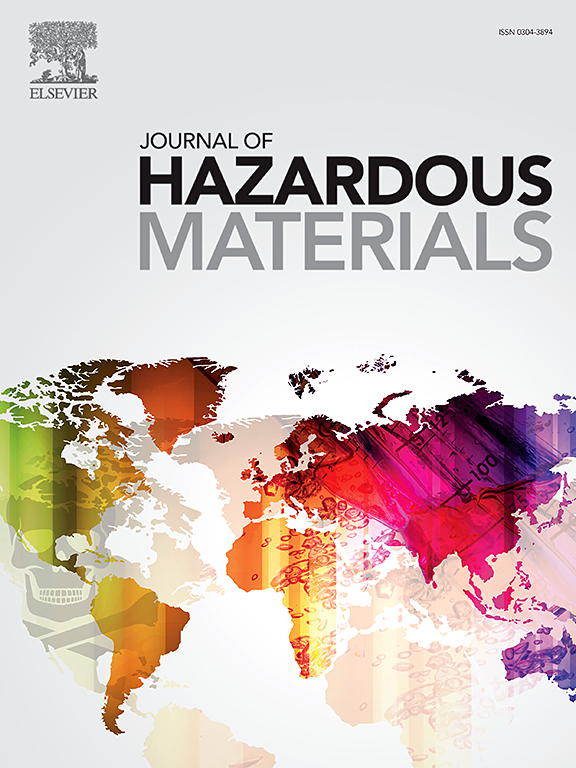用于高效和广谱吸附饮料中微/纳米塑料的工程磁性金属有机框架
IF 11.3
1区 环境科学与生态学
Q1 ENGINEERING, ENVIRONMENTAL
引用次数: 0
摘要
微/纳米塑料由于其内在毒性和与共存污染物的协同效应,对环境生态系统和人类健康构成重大风险,引起了重大关注。尽管金属有机框架(mof)作为去除微塑料的有效吸附剂显示出很大的潜力,但控制其吸附机制的结构-活性关系仍然知之甚少。在这项研究中,设计和合成了工程磁性mof材料(Fe3O4@carboxymethyl-cellulose-MOFs)来吸附微/纳米塑料。系统地研究了五种Fe3O4@CMC-MOFs复合材料对微/纳米塑料的吸附行为,重点阐明了结构-性能关系。从结构差异出发,通过理化表征、吸附动力学及等温线、密度泛函等理论对吸附机理进行了系统分析。结果表明Fe3O4@carboxymethyl-cellulose@MIL-101-NH2主要通过范德华相互作用对聚苯乙烯(PS)表现出优异的吸附性能。在最佳条件下,Fe3O4@carboxymethyl-cellulose@MIL-101-NH2能吸附98.0%和245.1 mg/g PS,根据Langmuir等温线模型,最大吸附量为1923 mg/g。5次循环后,效率仍保持89.0%。对不同形状、微纳米尺寸、可充电性(250 mg/g)的其他类型的微塑料(聚丙烯和聚乙烯)也有满意的吸附性能。Fe3O4@carboxymethyl-cellulose@MIL-101-NH2能有效去除饮料中81.0%的微/纳米塑料。所开发的工程磁性mof材料具有优异的吸附性能、效率和成本效益,在环境和食品系统中对微/纳米塑料的去除具有很大的潜力。本文章由计算机程序翻译,如有差异,请以英文原文为准。

Engineered magnetic metal-organic frameworks for efficient and broad-spectrum adsorption of micro/nanoplastics in beverages
Micro/nanoplastics have raised significant concerns due to their intrinsic toxicity and synergistic effects with co-existing pollutants, posing substantial risks to environmental ecosystems and human health. Although metal-organic frameworks (MOFs) demonstrate promising potential as efficient adsorbents for microplastic removal, the structure-activity relationships governing their adsorption mechanisms remain poorly understood. In this study, engineered magnetic MOFs materials (Fe3O4@carboxymethyl-cellulose-MOFs) were designed and synthesized to adsorb micro/nanoplastics. The adsorption behavior of five Fe3O4@CMC-MOFs composites toward micro-/nanoplastics was systematically investigated, with particular emphasis on clarifying structure-property correlations. Furthermore, starting from the structural differences, the adsorption mechanism was systematically analyzed by physicochemical characterization, adsorption kinetics and isotherms, and density functional theory. Results showed that Fe3O4@carboxymethyl-cellulose@MIL-101-NH2 demonstrated superior adsorption performance for polystyrene (PS) mainly through van der Waals interactions. Under optimal conditions, Fe3O4@carboxymethyl-cellulose@MIL-101-NH2 enabled adsorbing 98.0% and 245.1 mg/g PS, the maximum adsorption amount was 1923 mg/g based on Langmuir isotherm model. And it remained >89.0% efficiency after five cycles. As well as it showed satisfactory adsorption performance for other types of microplastics such as (polypropylene and polyethylene) with different shapes, micro/nano-size, and chargeability (>250 mg/g). Moreover, Fe3O4@carboxymethyl-cellulose@MIL-101-NH2 can effectively remove >81.0% micro/nanoplastics in beverages. The developed engineered magnetic MOFs material has excellent adsorption performance, efficiency and cost-effectiveness, possessing great potential for the removal of micro/nanoplastics in environment and food systems.
求助全文
通过发布文献求助,成功后即可免费获取论文全文。
去求助
来源期刊

Journal of Hazardous Materials
工程技术-工程:环境
CiteScore
25.40
自引率
5.90%
发文量
3059
审稿时长
58 days
期刊介绍:
The Journal of Hazardous Materials serves as a global platform for promoting cutting-edge research in the field of Environmental Science and Engineering. Our publication features a wide range of articles, including full-length research papers, review articles, and perspectives, with the aim of enhancing our understanding of the dangers and risks associated with various materials concerning public health and the environment. It is important to note that the term "environmental contaminants" refers specifically to substances that pose hazardous effects through contamination, while excluding those that do not have such impacts on the environment or human health. Moreover, we emphasize the distinction between wastes and hazardous materials in order to provide further clarity on the scope of the journal. We have a keen interest in exploring specific compounds and microbial agents that have adverse effects on the environment.
 求助内容:
求助内容: 应助结果提醒方式:
应助结果提醒方式:


